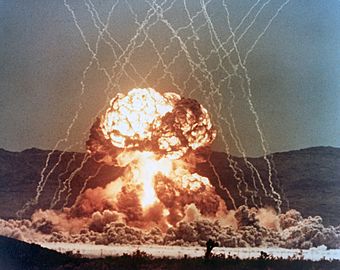Operation Teapot facts for kids
Operation Teapot was a series of 14 nuclear test explosions. These tests were carried out by the United States in 1955. They took place at the Nevada Test Site.
This operation came after Operation Castle and before Operation Wigwam. The main goals were to help the military learn how to fight on a nuclear battlefield. They also wanted to make nuclear weapons better for long-range attacks.
Contents
Key Nuclear Tests in Operation Teapot
Wasp Test: Military Training
During the Wasp test, soldiers practiced military exercises. An armored group moved very close to the explosion site. They were only about 900 meters (about half a mile) away. This happened while the mushroom cloud was still forming.
Bee Test: Marine Corps Participation
The United States Marine Corps had a special test unit. This unit took part in the Bee test. This happened during military exercises in March 1955.
MET Test: New Bomb Design
The MET test used a new type of bomb core. It was the first to mix uranium-233 with plutonium. Uranium-233 is a rare material used in nuclear weapons. This bomb was similar to a design from an earlier test in 1951.
The bomb was expected to be very powerful. However, it produced much less energy than planned. This unexpected lower power caused problems for many military tests. The designers had changed the bomb without telling the military.
Apple-2 Test: Survival Town
The Apple-2 test happened on May 5, 1955. Its purpose was to see how different buildings would hold up in a nuclear blast. A special area was built with houses and power stations. People called this area "Survival Town" or "Doom Town."
Mannequins were placed inside the buildings. Different types of food were also stored there. Not all the buildings were destroyed by the blast. Some of them can still be seen today at Area 1. A short film about this test, called "Operation Cue," was made to show people what happened.
The Apple-2 test also checked how nuclear explosions affected records and storage equipment. This information came from documents released in 1956.
Images for kids
See also
 In Spanish: Operación Teapot para niños
In Spanish: Operación Teapot para niños



